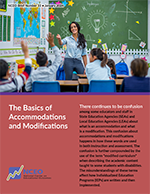There continues to be confusion among some educators and staff in State Education Agencies (SEAs) and Local Education Agencies (LEAs) about what is an accommodation and what is a modification. A recently published NCEO Brief, The Basics of Accommodations and Modifications (Brief #33), clarifies what accommodations and modifications are for both instruction and assessment for students with disabilities. The Brief also disentangles the use of the term “alternate or modified curriculum” from the meaning of modification used for instruction and assessment.
The primary purpose of accommodations and modifications is to provide access to learning for students with disabilities. The major difference between accommodations and modifications is that accommodations provide access to both instruction and assessment for students with disabilities without changing expectations for their learning or performance; whereas, modifications lower performance expectations on grade level content. Modifications for instruction are not the same as a modified curriculum.
The Brief provides recommendations for IEP teams, including:
- IEP teams should know which accommodations are allowable on assessments and provide students the opportunity to practice these accommodations during instruction. When the IEP team has determined that the allowable accommodation meets the student’s individual needs, it should be provided during assessments.
- The more aligned instruction and assessment accommodations are, the better students will be able to demonstrate what they know.
- Modifications should not be used for assessments because they produce invalid results for the content being assessed.
- Modifications should be used with caution for instruction because they change the learning expectations for students.
- Although instructional modifications may be appropriate for students with the most significant cognitive disabilities who take an AA-AAAS, those students still must be involved in and make progress in the general education curriculum.

